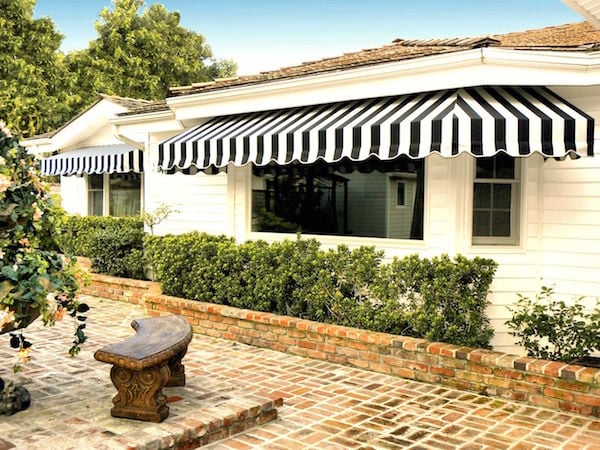
There are lots of ways we protect ourselves from the sun, wind, and rain. We wear sunglasses to save our eyes, hats to safeguard our heads, and visors to shield our face. So why would we expect less for our house, the ultimate example of shelter from the storm. But even our house sometimes needs a little sheltering when it comes to the weather. Outside surfaces get damaged, faded, or sustain heat buildup due to unnecessary exposure to the elements, and these problems eventually spread to the homeowner as well. So to protect certain open areas of the exterior, you may want to invest in an awning to act as a screen against the climate.
What Goes Where?
Since there are so many types of awnings, they can literally cast a shadow anywhere on the home. So most often they’re installed over open areas that can lead to harmful exposure. For instance, since we spend so much time on our porches, wouldn’t it be nice to sit outside without squinting or sweating. Why not eat breakfast on the balcony without risking sunburn? In fact, why let rain stop you from barbecuing on the patio? But smaller awnings can also be put above windows and doorways.
Window panes soak up a lot of sun and then transfer this solar energy into the home, which makes your AC run double-time. But a canopy can block this heat from the house as well as redirect rainwater from the foundation. And if you have a metal door it can get scorching hot in the summer, which is not only inconvenient but dangerous. An awning above the entryway is a cheap and easy way to remove heat buildup.
Awning Types
They’re available in varying shapes and styles, and they can come in any pattern, color, or size, so take your time in selecting a model that best fits your exterior. But the next step is choosing a particular design. Here are a few basic awning types:
- Stationary: A canopy permanently installed on the home’s exterior. It’s certainly sturdy and stable, but it can also collect snow and receive strong wind gusts. Therefore, hire an expert for installation to make sure it can endure the impact.
- Portable: These transportable awnings are built for convenience. They’re freestanding and can easily be moved from one location to another to be used anywhere they’re needed. They can even be moved to follow the trajectory of the rising and setting sun.
- Retractable: Probably the most popular model, these awnings can be rolled or folded up when not in use. Therefore they provide the sturdiness of a stationary unit without the threat of wind damage or snow buildup during inclement weather.
- Motorized: These awnings use an electric mechanism to roll the canopy and can even be operated by remote to keep you out of the rain. They’re also available with sensors that monitor the weather, activating the unit when it’s sunny and retracting it when the wind picks up. You may have to hire an electrician for installation, but always make sure the unit has an automatic override so if the motor breaks you can still hand crank it.
Ready to start your awning installation?
Find ProsTypes of Awning Material
The most popular material is canvas since it’s resilient and inexpensive. Plus, it’s flexible, which makes it great for retractable units. However, since it’s so elastic, it can sometimes become a basin for rain and snow, adding weight to the frame and creating a safety hazard. So have it installed by a professional who can make sure it is always stretched tight in order to avoid buildup.
Metal is another possible option. It’s strong and durable, but it’s also heavy and requires professional installation. Plus, it can sometimes absorb the sun’s heat and add to the heat transfer it’s trying to deflect. As for frames, you have to make sure they’re secure and sturdy, so often steel or aluminum supports are used. But if you have a small, canvas model, wood structures are still sometimes employed though they may be better for indoor units rather than exterior models.
 Cleaning Your Exteriors With a Pressure Washer
Cleaning Your Exteriors With a Pressure Washer  Awning Fabric: What Material Measures Up?
Awning Fabric: What Material Measures Up?  Going Green with Decks, Patios, and Porches
Going Green with Decks, Patios, and Porches  Aluminum Awnings: Made for Shade
Aluminum Awnings: Made for Shade  2017 Top Deck Designs for Remodeling the Perfect Entertaining Space
2017 Top Deck Designs for Remodeling the Perfect Entertaining Space 

Are You Familiar With This Topic? Share Your Experience.